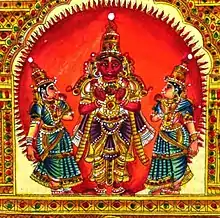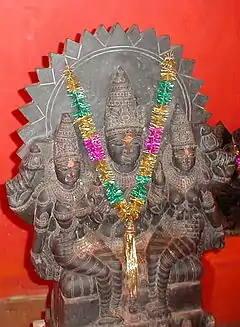Saranyu
Saranyu (Sanskrit: सरन्यू, IAST: Saraṇyū), also known as Samjna (Sanskrit: संज्ञा, IAST: Samjñā; also spelled Sanjna) and Sandhya (Sanskrit: सन्ध्या), is a Hindu goddess and the chief consort of Surya, the Sun god. She is one of the earliest goddesses in the pantheon and is found in the Rigveda. Saranyu also appears in later texts including the Harivamsa and the Markandeya Purana. The most prominent legend of Saranyu is about her temporary abandonment of Surya and creation of Chhaya. In most texts, Saranyu is the mother of the death god Yama, the river-goddess Yami, the current Manu, the divine twin physicians Ashvins and the god Revanta.
| Saranyu | |
|---|---|
Goddess of Clouds and Dusk | |
 Surya with consorts Sanjna and Chhaya | |
| Other names | Samjna, Sandhya, Sanjana, Suvarchala, Randal, Sauri |
| Devanagari | सरन्यू |
| Sanskrit transliteration | Saranyu |
| Affiliation | Devi |
| Gender | Female |
| Personal information | |
| Parents |
|
| Siblings | Trisiras (twin brother) Chhaya (reflection) |
| Consort | Surya |
| Children | Yama, Yami, Ashvins, Shraddhadeva Manu and Revanta |
Etymology and epithets
Saraṇyū is the female form of the adjective saraṇyú, meaning "quick, fleet, nimble", used for rivers and wind in the Rigveda (compare also Sarayu).[1] Saranyu has been described as "the swift-speeding storm cloud".[2] In the later text named Harivamsa (5th century C.E.), Saranyu is known as Sanjna or Samjna (pronounced. Sangya), which means 'image', 'sign' or 'name'. In the Puranas, Samjna is known by many other names including Sandhya, Sanjana and Suvarchala.[3][4]
Textual sources and family

The earliest evidence of Saranyu is found in the Rigveda (c. 1200-1000 BCE), where she is described to be the daughter of deity Tvastar, who is known as Vishwakarma in later texts, and she has a twin brother named Trisiras.[1] Her husband is referred as Vivasvan, which is the another name of Surya. With him, she has six children — Yama, Yami, Shraddhadeva Manu, the two Ashvins and Revanta. Savarna, a mortal, takes Saranyu's place for a temporary time. After some centuries, the same story is recited in Yaksha's Nirukta (c. 500 B.C.E) and adds Savarni Manu as Savarna's son. The Bṛihaddevatā also narrates the same story with additional details of Ashvin's birth.[3] In the epic Harivamsa (c. 5th century C.E.), everything remains the same but Savarna is her shadow now. Later in the Puranas like the Markandeya Purana, Matsya Purana and Kurma, Samjna is directly referred to as Vishwakarma's daughter and her shadow is named Chhaya. However in Bhagavata Purana, Chhaya is her biological sister.[5] Most sources indicate that the children of Surya by Saranyu are:
- Shraddhadeva Manu — ancestor of humans[3][6]
- Yama — Lord of Death[3][6]
- Yami — Lady of Yamuna[3][6]
- Ashvins — The divine twin physicians.[7]
- Revanta — Master of horses[7][3][6]
Some texts present a different list of her children. As per Kurma Purana and Bhagavata Purana, Sanjna has only three children — Shraddhadeva Manu, Yama and Yamuna (Yami).[4][5]
Vedic legends
The earliest narrative of Saranyu's story is found in the Rigveda. As per the story, Saranyu and her three-headed twin are the children of craftsman deity Tvastar (Vishvakarma). He arranges his daughter's marriage with Vivasvan (Surya). After the birth of the twins — Yama and Yami, Saranyu abandons her husband. Before leaving, she appoints a mortal woman called Savarna to take care of her children. Here Savarna is a similar looking woman but in the later texts, she is Saranyu's mere shadow. Saranyu, in the form of mare, roams in a forest. Surya, after realising his wife's absence, follows her in the form of a stallion. After he finds her, they engage in love making and she gives birth to the Ashvins.[3]
Epic legends
_LACMA_M.83.1.7_(1_of_2).jpg.webp)
The next major appearance of Saranyu is found in the Harivamsa, an appendix of the Mahabharata. This version provides a detailed account of the legend. Here, Saranyu remains as the daughter of Tvastar (Vishvakarma) but she is known as Samjna or Sanjana. Surya is the son of Kashyapa and Aditi. Sanjana is unsatisfied with her married life as Surya is unpleasant to her because of his mighty heat, which has burnt himself. From him, Sanjana gives birth to Shraddhadeva Manu, Yama and Yami. After the birth of Yama and Yami, Sanjana is not able to tolerate more and decides to abandon her husband. Before leaving, she creates a lady from her shadow and asks her to take care of the children. The look alike Sanjana is called Chhaya in the Puranic texts but here she is unnamed. After Sanjana reached her father's abode, Tvastar asks her to return. Sanjana, then assumes the form of a mare and roams in the forest of Kuru. Meanwhile, Surya, unaware of the replacement, impregnates the look alike lady with Savarni Manu and Shani. After their birth, she becomes partial to her children. Enraged, Yama threatens her with his leg, but is cursed to lose his leg by her. This behaviour of a mother to her child makes Surya suspicious and later the look alike discloses the whole incident. Surya goes to his father in law, and asks him to cure his splendor. Tvastar then reduces Surya's glory, making him pleasant. After finding Sanjana, Surya makes love with her in the form of a stallion and she gives birth to the Ashvins. He then shows his normal form to her. Sanjana is pleased to see her husband's beauty and returns to her abode with her new-born twins.[3]
Puranic legends
Sanjna's story is retold in multiple Puranas. Among them, one in the Markandeya Purana is the most popular. The legend is found twice in the text and it shares similarities with the Harivamsa one. Major differences are noted here. After the birth of Manu, Sanjana's behaviour changes as she is unable to bear the heat of Surya's splendor. Her behaviour angers Surya and he curses her next born children. When Yama and Yami are born, Sanjana creates Chhaya and goes to her father's house but is asked to return. This time, Chhaya has three children — Shani, Another Manu and Tapati. After she curses Yama to be infected with worms and lose his leg, Surya gets to know that the same looking woman was not Yama's mother due to the harsh punishment which a mother can't think of. Unlike the previous version, Surya asks his father in law to reduce his heat after the birth of Ashvins.[3] Some chapters also add Revant, the divine master of horses, as the son of Sanjana.[7]
In the Vishnu Purana, similar legend is recited by Parashara. Sanjana, after giving birth to three children, leaves to gain control over Surya's heat by performing tapas in the forest. Before leaving, she creates Chhaya, who becomes the mother of three children mentioned earlier. After the curse, Surya finds the mare Sanjana in nothern Kuru and makes love with her in the form of a stallion. This results Sanjana giving birth to three children — the two Ashvins and Revanta. Later Vishvakarma reduces Surya's heat.[8] The Matsya Purana also narrate the event.[9] In many Puranas, Vishvakarma uses Surya's heat to create many celestial weapons.[6]
References
- Kinsley, David R (1986). Hindu Goddesses: Vision of the Divine Feminine in the Hindu Religious Traditions. University of California Press. ISBN 81-208-0379-5.
- Chisholm, Hugh, ed. (1911). . Encyclopædia Britannica. 9 (11th ed.). Cambridge University Press. p. 745.
- Doniger, Wendy (1998). "Saranyu/Samjna". In John Stratton Hawley, Donna Marie Wulff (ed.). Devī: goddesses of India. Motilal Banarsidas. pp. 154–7. ISBN 81-208-1491-6.
- Daniélou, Alain (December 1991). The Myths and Gods of India: The Classic Work on Hindu Polytheism from the Princeton Bollingen Series. Inner Traditions / Bear & Co. ISBN 978-0-89281-354-4.
- Prabhupada. "Bhaktivedanta VedaBase: Śrīmad Bhāgavatam: Chapter 13: Description of Future Manus". The Bhaktivedanta Book Trust International, Inc. Archived from the original on 15 February 2011. Retrieved 5 July 2010.
- Puranic Encyclopedia: a comprehensive dictionary with special reference to the epic and Puranic literature, Vettam Mani, Motilal Banarsidass, Delhi, 1975, p. Samjñā
- Singh, Nagendra Kumar (1997), "Revanta in Puranic Literature and Art", Encyclopaedia of Hinduism, 44, Anmol Publications, pp. 2605–19, ISBN 81-7488-168-9
- Wilson, Horace Hayman (1866). "II". The Vishńu Puráńa: a system of Hindu mythology and tradition. 8. London: Trubner & Co. pp. 20–23.
- Pattanaik, Devdutt (September 2000). The Goddess in India: The Five Faces of the Eternal Feminine. Inner Traditions / Bear & Co. ISBN 978-0-89281-807-5.

